The shift toward digital tools and changing workplace expectations has turned remote work from a short-term fix into a long-term strategy for modern businesses.
Companies are now embracing remote customer service as a scalable, high-impact model for delivering exceptional support from anywhere in the world.
According to Findstack, the number of people who work from home has risen by 159%, since 2009.
This flexibility helps teams stay agile, responsive, and focused without the limits of a traditional office.
But with this freedom comes a unique set of challenges. How do you keep your team motivated, aligned, and performing at their peak when you’re not in the same room?
In this article, we’ll explore the benefits of remote customer service and share practical tips to help you build and manage a high-performing remote support team.
What is remote customer service?
Remote customer service is the practice of delivering customer assistance from locations outside a traditional office setting.
This approach involves utilizing digital communication tools such as live chat software, email, phone, video conferencing, and co-browsing to address customer inquiries and provide guidance from anywhere in the world.
With the help of automation, AI, and communication across multiple channels, they can provide quick and personalized service through the customer’s preferred method.
Key differences between on-site and remote customer service
On-site and remote customer service models each offer distinct advantages.
Understanding how they differ can help you build a support strategy that balances team performance, customer needs, and operational flexibility.
| Aspect | On-site | Remote |
| Interaction style | In-person interactions with customers | Digital interactions via chat, email, phone, or video |
| Workspace | Office-based environment with physical workstations | Home offices or any remote location with internet access |
| Work hours | Structured and fixed schedules | Flexible working hours, often allowing for 24/7 coverage |
| Commute | Requires daily commutes to a centralized office | No commute, reducing stress and saving time |
| Talent access | Limited to local candidates | Access to a global talent pool |
| Operational costs | Higher overhead costs (office space, utilities, etc.) | Lower operational expenses (minimal overhead and reduced infrastructure needs) |
| Scalability | Constrained by physical space | Highly scalable with cloud-based tools |
| Management style | Direct in-person supervision and immediate feedback | Remote monitoring, virtual coaching, and digital performance tools |
| Technology requirement | Standard in-office infrastructure | Robust digital tools, cloud systems, and cybersecurity measures |
Benefits of providing remote customer support
Remote customer support offers a modern, flexible approach to service that meets customers wherever they are.
By breaking free from traditional office setups, support teams can operate virtually from anywhere, across different time zones, and deliver exceptional support around the clock.
Let’s explore the benefits of remote customer support for business operations.
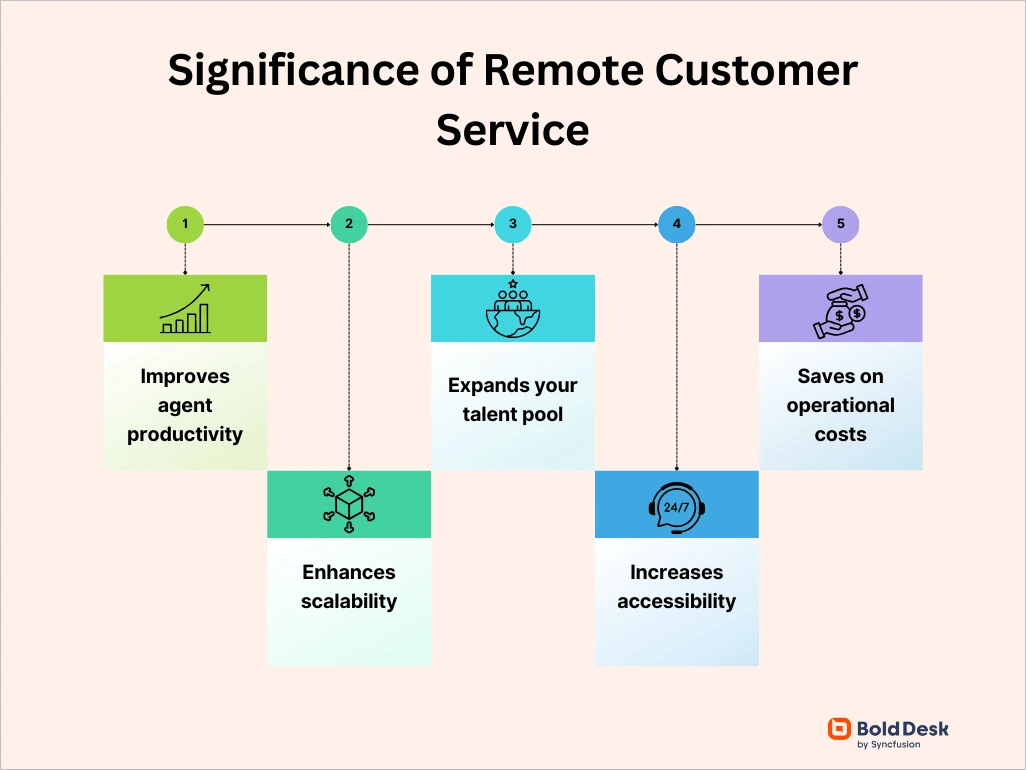
- Improves agent productivity through flexible work environments: Distractions such as constant noise and interruptions can hinder an agent’s ability to engage effectively with customers. Remote work allows agents to work during their most productive times and achieve a healthier work-life balance, resulting in better performance.
- Enhances scalability to meet fluctuating customer demand: Remote customer support allows businesses to easily adjust team size in response to fluctuating needs, unlike traditional call centers with fixed capacities. This flexibility enables quick responses during peak times without the complications of expanding physical office space.
- Expands your talent pool for specialized support teams: Companies can recruit skilled professionals globally, often at lower costs, while ensuring high service quality. This approach fosters the creation of diverse, inclusive, and stable customer support teams. It also expands the talent pool for specialized support teams by eliminating location constraints in hiring.
- Increases accessibility for seamless customer support: Remote customer service representatives provide 24/7 customer service through online platforms, allowing customers to contact them via chat, email, or social media at their convenience. This ensures timely and personalized responses to all inquiries in real time.
- Saves on operational costs: A study by Bizlaunch indicates that 71% of businesses find remote work cost-effective. By cutting overhead expenses, such as utilities and office supplies, businesses can optimize resource allocation and reallocate funds to essential areas like product development.
Types of remote customer support
Remote customer service teams use multiple channels and technologies to provide support without being physically present in an office.
Each channel caters to different customer needs and preferences.
Email support
Remote agents manage customer inquiries through email using ticketing systems to track, prioritize, and resolve issues. This approach allows for:
- Detailed documentation of all customer interactions
- Efficient routing of specialized questions to appropriate experts
- Clear resolution paths for complex problems requiring multiple steps
- Thorough responses with supporting documentation when needed
Live chat support
Agents use web-based chat platforms to engage with customers in real-time, offering immediate assistance through:
- Instant responses to straightforward questions
- Guided navigation through website features
- Concurrent handling of multiple customer conversations
- Proactive engagement based on customer behavior patterns
Phone support
For situations requiring direct conversation, remote agents provide voice-based assistance through:
- Clear verbal explanations for complex issues
- Empathetic human connection for sensitive matters
- Step-by-step troubleshooting with immediate feedback
- Personalized service that builds stronger customer relationships
Social media support
Agents monitor and respond to customer interactions across platforms like Facebook, X, Instagram, and WhatsApp, focusing on:
- Public and private message management
- Brand reputation maintenance through timely responses
- Community engagement and relationship building
- Trend identification through social listening
Online resource portals
Self-service tools, such as knowledge bases, FAQs, video tutorials, and interactive guides, empower customers to find solutions independently. Remote teams:
- Create and maintain comprehensive documentation
- Analyze usage patterns to identify content gaps
- Update resources based on emerging issues and solutions
- Develop multimedia content for different learning styles
Remote support teams often integrate these channels into an omnichannel approach, ensuring consistent customer experiences regardless of which communication method customers choose.
Challenges remote customer service agents face and their solutions
Working remotely offers many advantages, including flexibility, comfort, and independence, but it also presents unique challenges.
Recognizing these issues and applying effective solutions is crucial for delivering outstanding remote customer support. They include:
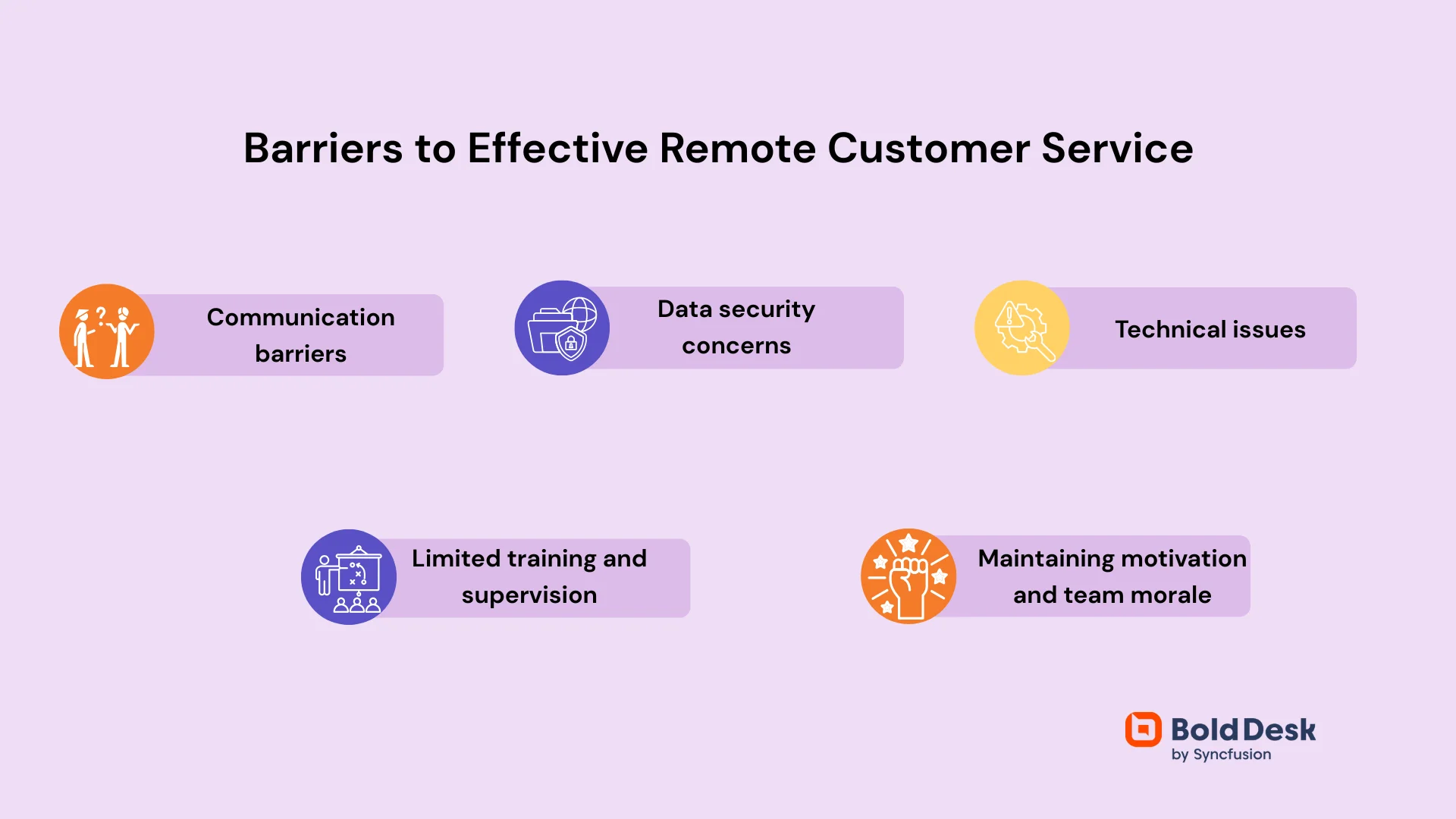
Communication barriers
Remote customer service can lead to fragmented communication and increased misunderstandings, which negatively impact service quality and team cohesion.
Solution
- Implement robust video conferencing platforms for regular team meetings
- Set clear communication protocols and escalation paths for urgent matters
- Leverage real-time collaborative workspaces such as Slack or MS Teams with designated channels for different types of communication
- Preserve communication logs with clear agendas, documented action items, and designated note-takers
Data security concerns
Handling sensitive customer and company data in remote environments introduces significant security risks.
Solution
- Set up end-to-end encryption for all customer communications
- Provide company-issued devices with pre-installed security measures
- Establish VPN requirements for accessing company systems
- Implement multi-factor authentication for all system access
Technical issues
Connectivity issues and technical glitches, such as system lags when working remotely, can disrupt service and frustrate both support agents and customers.
Solution
- Encourage the use of high-speed, reliable internet connections, and provide technical support when needed
- Establish clear protocols for technology failures
- Conduct routine maintenance and system updates to reduce disruptions
- Implement proactive software monitoring to detect potential issues before they escalate
Limited training and supervision
Ensuring proper skill development and service standards without direct observation presents unique challenges in remote environments.
Solution
- Implement shadow sessions where new agents can observe experienced team members
- Develop a robust knowledge base with training materials, product information, and updates
- Provide the remote agent with continuous learning through webinars and online workshops
- Utilize reporting and analytics tools to monitor agent performance and provide feedback
Maintaining motivation and team morale
Remote employees often experience feelings of isolation, which can diminish their motivation and engagement.
They may also face physical and mental distractions that impact their performance.
Solution
- Recognize achievements publicly through digital channels
- Promote mental wellness through supportive policies and resources
- Connect individual work to company impact and customer outcomes through regular updates
- Schedule virtual team-building activities and social events
Actionable tips to deliver exceptional remote customer service
Exceptional remote customer service involves creating personalized and efficient experiences for customers, regardless of their location.
By utilizing appropriate technology and maintaining clear communication, support teams can effectively address the challenges of distance and provide outstanding service.
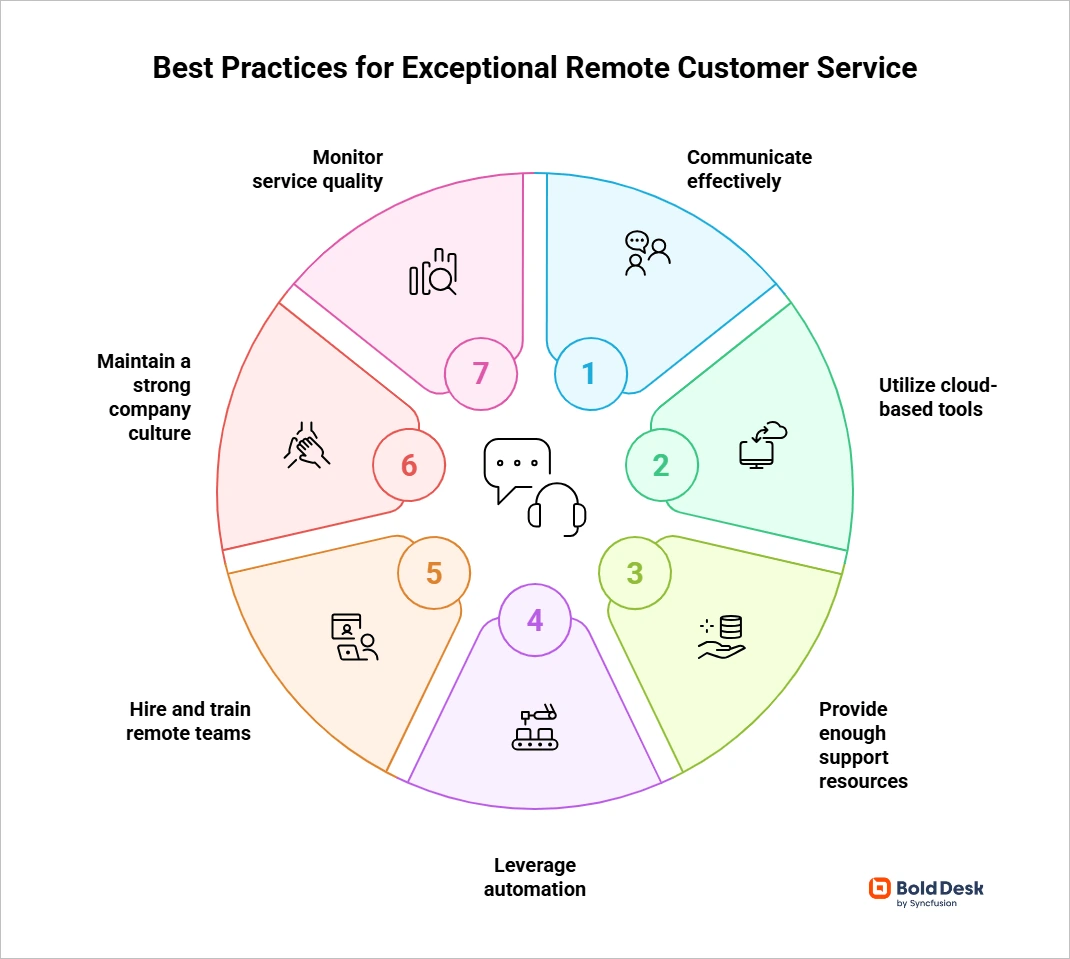
Communicate effectively
Communication is the key, the cliché slogan we all know. But in remote customer service, it’s more than a cliché; it’s essential.
Pro tips:
- Implement shared note systems for customer interactions.
- Arrange for frequent video meetings to share tips, discuss in-house issues, and share knowledge.
- Establish communication standards, define expected response times, preferred channels, and escalation paths.
Adopt cloud-based customer service tools
From a Fortune business insights survey, 66% of businesses are planning to move to cloud-based solutions for customer service operations.
This shift reflects a growing recognition of the flexibility, scalability, and efficiency that cloud-based customer service platforms offer to meet fluctuating customer demands.
Pro tips:
- Implement a help desk ticketing system to track, organize, and route customer support tickets and conversations to the appropriate agents.
- Use task management tools to delegate, set deadlines, and monitor agent progress remotely.
- Adopt omnichannel customer service to empower your remote team to manage all customer requests from email, live chat, SMS, and social media platforms in one unified inbox.
Empower your team with self-help resources
Time zone differences can be a challenge in remote work. Agents may need information to solve customer inquiries during nightfall in your area.
Pro tips:
- Use cloud-based storage tools such as Google Drive to assist your remote agents in storing and retrieving necessary data.
- Ensure collaboration among remote teams with a comprehensive knowledge base software, to easily access information, share private notes, and discuss among themselves.
- Develop structured guidance for common scenarios.
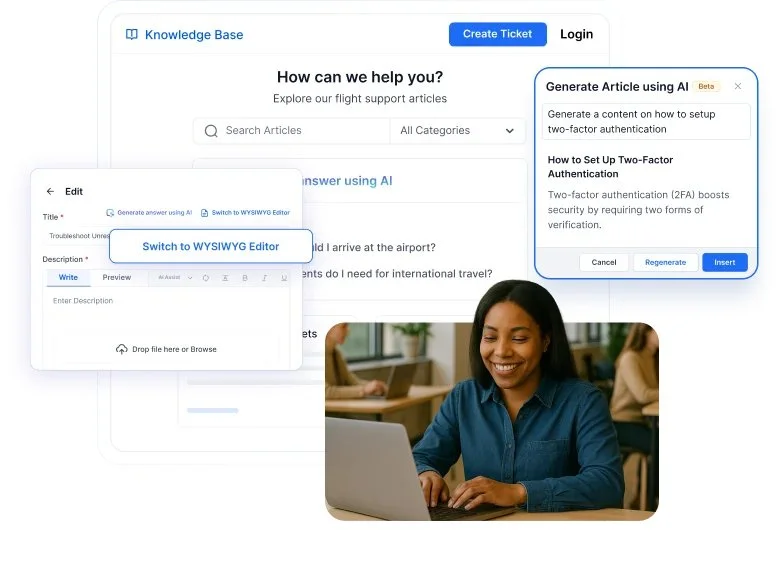
Leverage automation to boost efficiency
According to Gartner, one in 10 agent interactions (10%) will be automated by 2026, an increase from an estimated 1.6% in 2022.
Implement AI and automation to complement remote support agents in streamlining workflows and responding to customer inquiries effectively.
Pro tips:
- Use an AI agent to handle simple, repetitive inquiries and let your remote team manage complex customer queries that require expertise.
- Automate recurring processes like smart ticket routing to save time and avoid burnout.
- Optimize escalation workflows for overdue tickets so that urgent issues can be handled promptly.
Hire the right team and ensure continuous training
Hiring remote agents isn’t just about skills; it’s about finding the right fit for remote work and training them to be suitable for the role.
Consider global talent to diversify your team and ensure alignment with company values and remote work culture.
Pro tips:
- Recruit individuals who demonstrate accountability, self-motivation, adaptability, and strong communication skills.
- Clearly define roles, expectations, and performance goals during the onboarding of remote customer service agents.
- Offer comprehensive virtual customer service training sessions via online meeting platforms like Zoom, Microsoft Teams, or Google Meet. Record sessions for future reference and learning.
Maintain a strong company culture
Company values and ethics should be upheld even when working remotely. If teamwork is a core aspect of your culture, ensure your remote team embraces it.
Pro tips:
- Hold regular video meetups to define and communicate company values, mission, and vision statements.
- Encourage teamwork, recognize achievements, and ensure your remote agents feel connected to your broader organizational culture.
- Launch an internal newsletter to highlight quality work, milestones, and birthdays with the entire team publicly.
Monitor service quality with key metrics
Data-driven management ensures remote teams maintain high standards. Manage your remote team’s performance by tracking customer service KPIs.
Tips for tracking service quality:
- Measure customer service metrics such as customer satisfaction score (CSAT) by collecting feedback after each ticket resolution using survey questions.
- Provide agents with individual dashboards to monitor personal performance.
- Measure the average response time and first contact resolution rate to track efficiency.
In addition, identify the factors that impact your remote team’s performance and make appropriate changes to your customer service training and coaching.
Strengthen remote customer service for long-term success
The shift to remote customer service represents a fundamental transformation in how businesses support their customers. One that offers tremendous advantages in terms of talent access, operational flexibility, and cost efficiency when implemented correctly.
BoldDesk simplifies remote team management with powerful features designed to enhance communication, streamline workflows, and boost productivity.
Ready to level up your customer support strategy? Contact our support team today and start building a remote service experience that delights customers.
Did you find the best practices workable and helpful? We would love your thoughts and additional tips in the comments section below.
Related articles
- Digital Customer Service: Benefits, 7 Best Practices and Examples
- Online Customer Service [Best Ways to Improve It]
- 20 Best Customer Service Software Solutions for 2025
Frequently Asked Questions
A remote customer service team is a group of customer support professionals who work from various locations outside of a traditional office environment.
Instead of being physically present in a central location, remote team members operate from home offices or other remote settings, often using advanced customer service technology to communicate with customers and collaborate with each other.
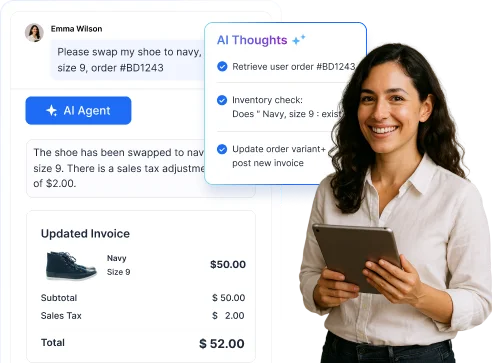


















 Email Ticketing System
Email Ticketing System Shared Inbox Software
Shared Inbox Software Multi Brand Help Desk
Multi Brand Help Desk Internal Help Desk Software
Internal Help Desk Software Trouble Ticketing Software
Trouble Ticketing Software Mobile Help Desk
Mobile Help Desk 
















